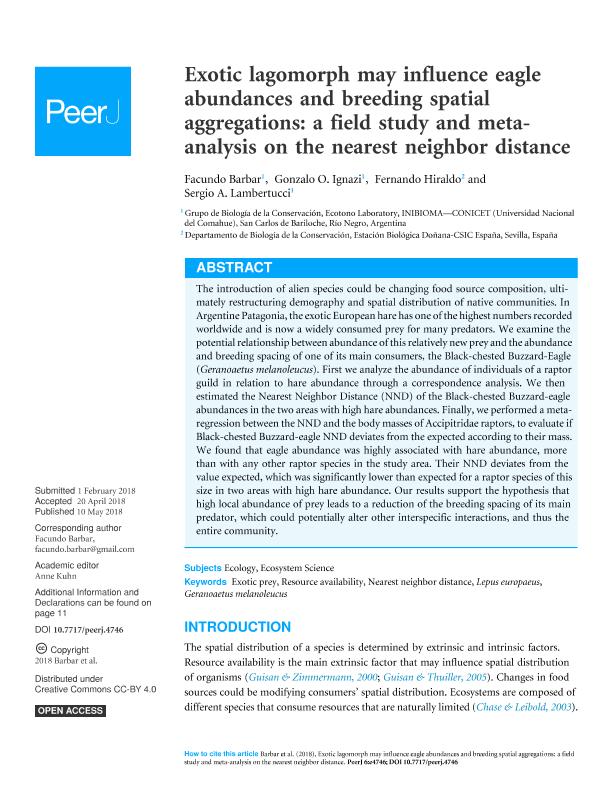Mostrar el registro sencillo del ítem
dc.contributor.author
Barbar, Facundo

dc.contributor.author
Ignazi, Gonzalo Oscar

dc.contributor.author
Hiraldo, Fernando

dc.contributor.author
Lambertucci, Sergio Agustin

dc.date.available
2020-01-02T23:09:02Z
dc.date.issued
2018-05-10
dc.identifier.citation
Barbar, Facundo; Ignazi, Gonzalo Oscar; Hiraldo, Fernando; Lambertucci, Sergio Agustin; Exotic lagomorph may influence eagle abundances and breeding spatial aggregations: A field study and meta- analysis on the nearest neighbor distance; PeerJ; PeerJ; 2018; 10-5-2018; 1-17
dc.identifier.issn
2167-8359
dc.identifier.uri
http://hdl.handle.net/11336/93345
dc.description.abstract
The introduction of alien species could be changing food source composition, ultimately restructuring demography and spatial distribution of native communities. In Argentine Patagonia, the exotic European hare has one of the highest numbers recorded worldwide and is now a widely consumed prey for many predators. We examine the potential relationship between abundance of this relatively new prey and the abundance and breeding spacing of one of its main consumers, the Black-chested Buzzard-Eagle (Geranoaetus melanoleucus). First we analyze the abundance of individuals of a raptor guild in relation to hare abundance through a correspondence analysis. We then estimated the Nearest Neighbor Distance (NND) of the Black-chested Buzzard-eagle abundances in the two areas with high hare abundances. Finally, we performed a metaregression between the NND and the body masses of Accipitridae raptors, to evaluate if Black-chested Buzzard-eagle NND deviates from the expected according to their mass. We found that eagle abundance was highly associated with hare abundance, more than with any other raptor species in the study area. Their NND deviates from the value expected, which was significantly lower than expected for a raptor species of this size in two areas with high hare abundance. Our results support the hypothesis that high local abundance of prey leads to a reduction of the breeding spacing of its main predator, which could potentially alter other interspecific interactions, and thus the entire community.
dc.format
application/pdf
dc.language.iso
eng
dc.publisher
PeerJ
dc.rights
info:eu-repo/semantics/openAccess
dc.rights.uri
https://creativecommons.org/licenses/by/2.5/ar/
dc.subject
EXOTIC PREY
dc.subject
GERANOAETUS MELANOLEUCUS
dc.subject
LEPUS EUROPAEUS
dc.subject
NEAREST NEIGHBOR DISTANCE
dc.subject
RESOURCE AVAILABILITY
dc.subject.classification
Conservación de la Biodiversidad

dc.subject.classification
Ciencias Biológicas

dc.subject.classification
CIENCIAS NATURALES Y EXACTAS

dc.title
Exotic lagomorph may influence eagle abundances and breeding spatial aggregations: A field study and meta- analysis on the nearest neighbor distance
dc.type
info:eu-repo/semantics/article
dc.type
info:ar-repo/semantics/artículo
dc.type
info:eu-repo/semantics/publishedVersion
dc.date.updated
2019-10-10T13:54:26Z
dc.journal.volume
2018
dc.journal.pagination
1-17
dc.journal.pais
Estados Unidos

dc.journal.ciudad
Nueva York
dc.description.fil
Fil: Barbar, Facundo. Consejo Nacional de Investigaciones Científicas y Técnicas. Centro Científico Tecnológico Conicet - Patagonia Norte. Instituto de Investigaciones en Biodiversidad y Medioambiente. Universidad Nacional del Comahue. Centro Regional Universidad Bariloche. Instituto de Investigaciones en Biodiversidad y Medioambiente; Argentina
dc.description.fil
Fil: Ignazi, Gonzalo Oscar. Consejo Nacional de Investigaciones Científicas y Técnicas. Centro Científico Tecnológico Conicet - Patagonia Norte. Instituto de Investigaciones en Biodiversidad y Medioambiente. Universidad Nacional del Comahue. Centro Regional Universidad Bariloche. Instituto de Investigaciones en Biodiversidad y Medioambiente; Argentina
dc.description.fil
Fil: Hiraldo, Fernando. Consejo Superior de Investigaciones Científicas. Estación Biológica de Doñana; España
dc.description.fil
Fil: Lambertucci, Sergio Agustin. Consejo Nacional de Investigaciones Científicas y Técnicas. Centro Científico Tecnológico Conicet - Patagonia Norte. Instituto de Investigaciones en Biodiversidad y Medioambiente. Universidad Nacional del Comahue. Centro Regional Universidad Bariloche. Instituto de Investigaciones en Biodiversidad y Medioambiente; Argentina
dc.journal.title
PeerJ
dc.relation.alternativeid
info:eu-repo/semantics/altIdentifier/url/https://peerj.com/articles/4746/
dc.relation.alternativeid
info:eu-repo/semantics/altIdentifier/doi/http://dx.doi.org/10.7717/peerj.4746
Archivos asociados
